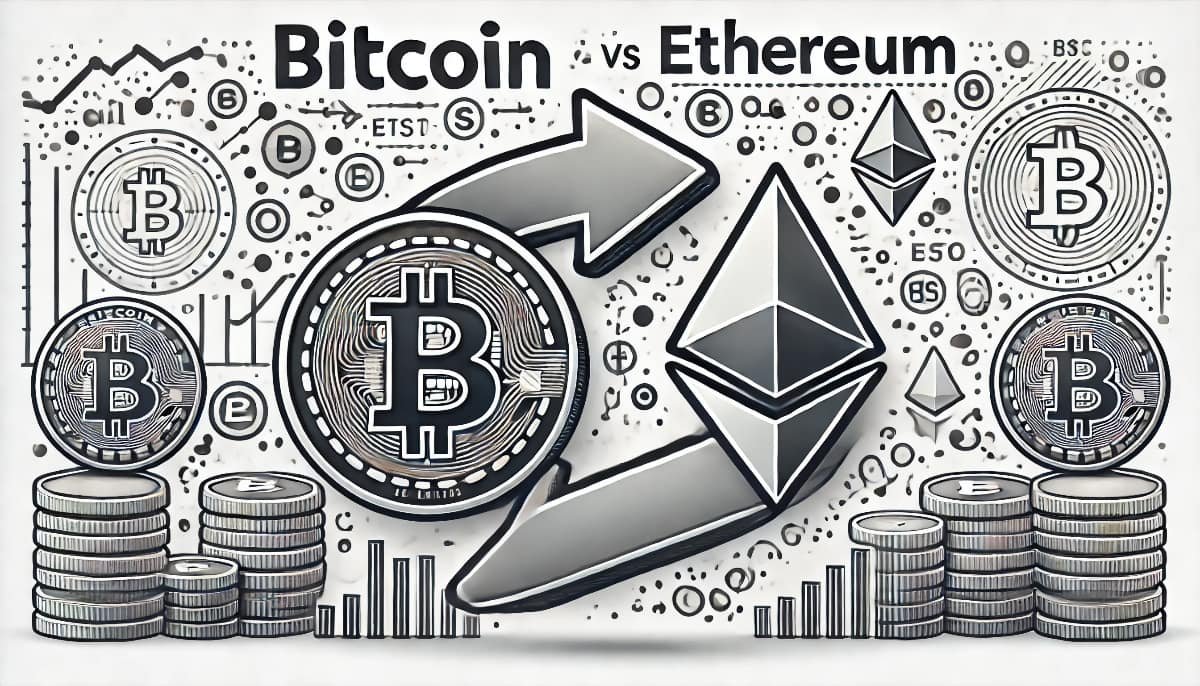Introduction to Bitcoin and Ethereum
In the ever-evolving world of cryptocurrencies, Bitcoin and Ethereum stand out as the two most prominent and influential digital assets. While both have garnered significant attention and adoption, they serve different purposes and offer unique features. This article delves into the key differences between Bitcoin and Ethereum, exploring their practical uses, technological foundations, and the impact they have on the broader financial ecosystem.
Origins and Foundational Concepts
Bitcoin: The Pioneer of Cryptocurrencies
Bitcoin, introduced in 2009 by an anonymous entity known as Satoshi Nakamoto, is widely regarded as the first cryptocurrency. It was created as a decentralised digital currency that operates without a central authority, relying on a peer-to-peer network to facilitate transactions. Bitcoin’s primary purpose is to serve as a digital alternative to traditional fiat currencies, offering a secure and transparent means of transferring value.
Ethereum: Beyond Digital Currency
Ethereum, launched in 2015 by Vitalik Buterin and a team of developers, is a blockchain platform that extends beyond the concept of digital currency. While it has its own cryptocurrency, Ether (ETH), Ethereum’s primary innovation lies in its ability to support smart contracts and decentralised applications (dApps). This flexibility has positioned Ethereum as a versatile platform for a wide range of use cases, from finance to supply chain management.
Technological Foundations
Blockchain Architecture
Both Bitcoin and Ethereum operate on blockchain technology, but their architectures differ significantly.
- Bitcoin: Bitcoin’s blockchain is designed to be a simple and secure ledger for recording transactions. It uses a proof-of-work (PoW) consensus mechanism, where miners solve complex mathematical problems to validate transactions and add them to the blockchain.
- Ethereum: Ethereum’s blockchain is more complex, supporting not only transactions but also smart contracts and dApps. It initially used PoW but is transitioning to a proof-of-stake (PoS) consensus mechanism with Ethereum 2.0, which aims to improve scalability and energy efficiency.
Smart Contracts and dApps
One of the most significant differences between Bitcoin and Ethereum is the latter’s support for smart contracts and dApps.
- Smart Contracts: Smart contracts are self-executing contracts with the terms of the agreement directly written into code. They automatically execute and enforce the terms when predefined conditions are met. Ethereum’s ability to support smart contracts has opened up a world of possibilities for decentralised applications.
- dApps: Decentralised applications (dApps) are applications that run on a blockchain network rather than a centralised server. Ethereum’s platform allows developers to create and deploy dApps, enabling a wide range of use cases, from decentralised finance (DeFi) to gaming and social media.
Practical Uses and Applications
Bitcoin: Digital Gold and Store of Value
Bitcoin is often referred to as “digital gold” due to its limited supply and store of value properties. Its primary use cases include:
- Store of Value: Many investors view Bitcoin as a hedge against inflation and economic instability, similar to how gold has been used historically.
- Medium of Exchange: While not as widely adopted for everyday transactions, Bitcoin can be used to purchase goods and services from merchants who accept it as payment.
- Remittances: Bitcoin offers a cost-effective and fast way to send money across borders, bypassing traditional financial intermediaries.
Ethereum: A Platform for Innovation
Ethereum’s versatility has led to a wide range of applications, including:
- Decentralised Finance (DeFi): Ethereum has become the backbone of the DeFi movement, enabling the creation of decentralised financial services such as lending, borrowing, and trading without intermediaries.
- Non-Fungible Tokens (NFTs): Ethereum’s support for NFTs has revolutionised the digital art and collectibles market, allowing artists and creators to tokenize and sell their work on the blockchain.
- Supply Chain Management: Ethereum’s smart contracts can be used to create transparent and tamper-proof supply chain solutions, ensuring the authenticity and traceability of products.
- Decentralised Autonomous Organisations (DAOs): DAOs are organisations governed by smart contracts, allowing for decentralised decision-making and management. Ethereum’s platform facilitates the creation and operation of DAOs.
Scalability and Performance
Bitcoin’s Scalability Challenges
Bitcoin’s scalability has been a topic of debate within the cryptocurrency community. The network’s limited transaction throughput and high fees during periods of congestion have led to calls for improvements. Solutions such as the Lightning Network, a layer-2 scaling solution, aim to address these issues by enabling faster and cheaper transactions off-chain.
Ethereum’s Transition to Ethereum 2.0
Ethereum has also faced scalability challenges, particularly as the popularity of dApps and DeFi has grown. The transition to Ethereum 2.0, which involves moving from PoW to PoS, aims to significantly improve the network’s scalability and performance. Key features of Ethereum 2.0 include:
- Shard Chains: Shard chains will divide the Ethereum network into smaller, more manageable pieces, allowing for parallel processing of transactions and smart contracts.
- Beacon Chain: The Beacon Chain will coordinate the network and manage the PoS consensus mechanism, ensuring security and efficiency.
Security and Consensus Mechanisms
Bitcoin’s Proof-of-Work (PoW)
Bitcoin’s PoW consensus mechanism relies on miners to validate transactions and secure the network. While PoW is considered highly secure, it is also energy-intensive, leading to concerns about its environmental impact.
Ethereum’s Transition from PoW to PoS
Ethereum’s transition to PoS with Ethereum 2.0 aims to address the energy consumption issues associated with PoW. PoS relies on validators who stake their Ether to secure the network and validate transactions. This approach is expected to be more energy-efficient and scalable.
Community and Development Ecosystem
Bitcoin’s Community and Development
Bitcoin’s development is driven by a global community of developers and contributors. The Bitcoin Core development team oversees the protocol’s maintenance and updates, with a focus on security and stability. The community’s conservative approach to changes ensures the network’s robustness but can slow down the adoption of new features.
Ethereum’s Vibrant Ecosystem
Ethereum boasts a vibrant and active development community, with numerous projects and initiatives built on its platform. The Ethereum Foundation, along with various independent developers and organisations, drives innovation and improvements. This dynamic ecosystem has led to rapid advancements and a diverse range of applications.
Market Dynamics and Adoption
Bitcoin’s Market Position
As the first cryptocurrency, Bitcoin has established itself as the market leader and a benchmark for the entire industry. Its market capitalisation and widespread recognition have made it a preferred choice for institutional investors and retail users alike.
Ethereum’s Growing Influence
Ethereum’s versatility and support for smart contracts have positioned it as a key player in the cryptocurrency space. Its growing influence in DeFi, NFTs, and other sectors has attracted significant attention and investment, solidifying its position as the second-largest cryptocurrency by market capitalisation.
Comparative Analysis
To summarise the key differences between Bitcoin and Ethereum, the following table provides a comparative analysis:
| Aspect | Bitcoin | Ethereum |
|---|---|---|
| Launch Year | 2009 | 2015 |
| Creator | Satoshi Nakamoto | Vitalik Buterin |
| Primary Purpose | Digital Currency | Smart Contracts and dApps |
| Consensus Mechanism | Proof-of-Work (PoW) | Transitioning from PoW to Proof-of-Stake (PoS) |
| Transaction Speed | ~7 transactions per second | ~30 transactions per second (expected to increase with Ethereum 2.0) |
| Supply Limit | 21 million BTC | No fixed supply limit |
| Main Use Cases | Store of Value, Medium of Exchange, Remittances | DeFi, NFTs, Supply Chain, DAOs |
Conclusion
Bitcoin and Ethereum, while both integral to the cryptocurrency landscape, serve distinct purposes and offer unique features. Bitcoin’s primary role as a digital currency and store of value contrasts with Ethereum’s versatile platform for smart contracts and decentralised applications. Understanding these differences is crucial for investors, developers, and users looking to navigate the evolving world of cryptocurrencies.
Bitcoin’s simplicity and security make it an attractive option for those seeking a digital alternative to traditional currencies. In contrast, Ethereum’s support for innovation and diverse applications positions it as a powerful tool for building a decentralised future. As both networks continue to evolve, their respective strengths and use cases will shape the broader financial ecosystem.

Q&A Section
- Q: What is the primary purpose of Bitcoin?
A: Bitcoin’s primary purpose is to serve as a digital currency and store of value, offering a secure and transparent means of transferring value. - Q: How does Ethereum differ from Bitcoin in terms of functionality?
A: Ethereum extends beyond digital currency by supporting smart contracts and decentralised applications (dApps), enabling a wide range of use cases. - Q: What consensus mechanism does Bitcoin use?
A: Bitcoin uses a proof-of-work (PoW) consensus mechanism, where miners solve complex mathematical problems to validate transactions. - Q: What is Ethereum 2.0, and why is it important?
A: Ethereum 2.0 is an upgrade to the Ethereum network that involves transitioning from PoW to proof-of-stake (PoS) to improve scalability and energy efficiency. - Q: What are some practical uses of Ethereum?
A: Ethereum is used for decentralised finance (DeFi), non-fungible tokens (NFTs), supply chain management, and decentralised autonomous organisations (DAOs), among other applications.
Further reading:
If you’re interested in understanding the differences and practical uses of Bitcoin and Ethereum, here are a few insightful articles that cover the key aspects:
- Investopedia provides a detailed overview of how Bitcoin was designed as an alternative to physical currency, focusing on being a store of value (often referred to as “digital gold”). Ethereum, on the other hand, is a platform for decentralized applications (dApps) and smart contracts, aiming to be the backbone of Web 3. One major technical difference is their consensus mechanisms: Bitcoin uses proof-of-work, while Ethereum transitioned to proof-of-stake in 2022 (Investopedia).
- Crypto.com highlights the distinct functionalities of the two cryptocurrencies. Bitcoin is primarily seen as a store of value, used for simple digital transactions, while Ethereum is much more versatile, supporting smart contracts and decentralized applications. The article also dives into the difference in their consensus mechanisms, with Ethereum moving to proof-of-stake for better scalability and reduced energy consumption (Crypto.com).
- Coin Bureau offers a comprehensive analysis comparing Bitcoin’s use as a store of value and its growing role in decentralized finance (DeFi), while Ethereum is positioned as the leading platform for decentralized apps. The article also explores recent technological advancements in both networks, such as Bitcoin’s Taproot upgrade and Ethereum’s scalability efforts (coin bureau).
- NerdWallet simplifies the comparison, explaining that Bitcoin was primarily designed as a payment system, while Ethereum is a full financial ecosystem, supporting smart contracts and complex financial software. The environmental impact of mining (proof-of-work) vs. staking (proof-of-stake) is also discussed (NerdWallet: Finance smarter).
- Blockonomi discusses how Bitcoin is considered a stable store of value with a fixed supply, whereas Ethereum is more flexible, with ongoing debates about its monetary policy. Ethereum’s smart contracts give it broader functionality, though it has faced scalability challenges that are being addressed with the transition to proof-of-stake (Blockonomi).
These articles provide an excellent foundation to explore the nuanced differences between Bitcoin and Ethereum and their evolving roles in the cryptocurrency space.














 How to trade CFD? (00:49)
How to trade CFD? (00:49) How to trade binary options*? (01:22)
How to trade binary options*? (01:22) Forex. How to start? (01:01)
Forex. How to start? (01:01)